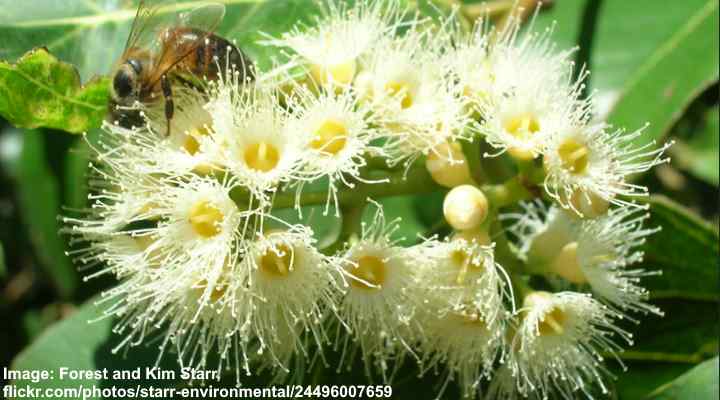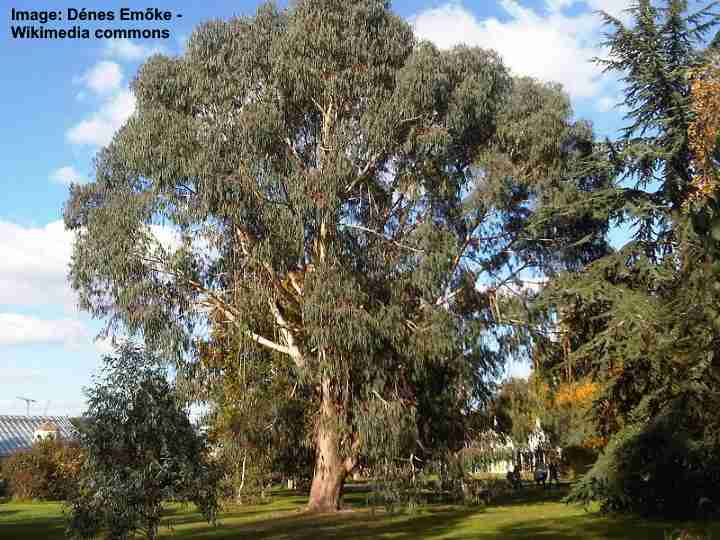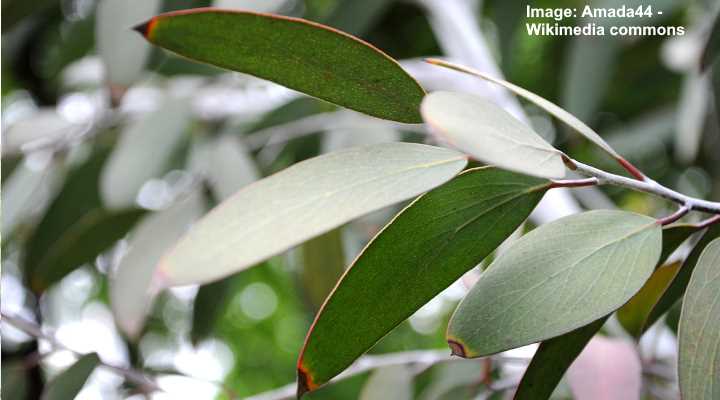Types of Eucalyptus Trees: Leaves, Flowers, Bark – Identification Guide (With Pictures)

Eucalyptus trees are species of large flowering trees and shrubs with aromatic leaves and attractive smooth peeling bark. Some types of Eucalyptus trees are called gum trees, and fruit from eucalyptus plants are called gumnuts. Eucalyptus plants are native to Australia but also grow in tropical and temperate climates throughout the world.
Some species of eucalyptus trees can grow as tall as 330 ft. (100 m). Eucalyptus shrubs—known as mallees—grow up to 33 ft. (10 m) tall.
Eucalyptus plants can grow well as houseplants in containers. However, eucalyptus plants are fast-growing shrubs and trees and may soon outgrow your indoor spaces. Some eucalyptus species grow as fast as 8 ft. (2 m) in one season.
In this article, you’ll find out about the most common eucalyptus trees. Descriptions and pictures of eucalyptus tree leaves, flowers, and bark will help identify eucalyptus shrub and tree species.
Facts About the Eucalyptus Plant
There are over 700 species of eucalyptus plants that grow as evergreen shrubs or medium to tall trees.
Common species of eucalyptus trees are the rainbow eucalyptus (Eucalyptus deglupta) that’s identified by its colorful bark, the lemon eucalyptus plant (Eucalyptus citriodora) with leaves giving off a citrusy lemon aroma, and the silver princess gum tree (Eucalyptus caesia).
Plants in the genus Eucalyptus belong to the myrtle family Myrtaceae.
Although eucalyptus trees mainly grow in Australia, they grow in many other North and South American, Asian, and European countries.
The leaves from the eucalyptus tree have an intense aroma, and oil from the leaves is used for producing essential oils. Eucalyptus leaves are also a source of food for one of Australia’s most famous bears—the koala bear.
Growing Eucalyptus Plants
Eucalyptus trees and shrubs are fast-growing plants that thrive in full sun. In their native habitat, most eucalyptus plants can’t grow in temperatures below 10°F (-12°C). Most eucalyptus plants grow in USDA zones 8 to 11. However, some species like the rainbow eucalyptus, are cold-hardy in zones 10 and 11.
Eucalyptus plants are attractive houseplants and thrive indoors. Potted eucalyptus plants can grow up to 8 ft. (2 m) from seed in one season. You should place the eucalyptus houseplant in full sun and grow in a well-draining potting mix. If you grow potted eucalyptus on the patio outdoors in summer, bring it inside before the first frost.
Eucalyptus Tree Leaves

Eucalyptus leaves can vary in shape, depending on the tree species and its maturity
Most eucalyptus trees have evergreen leaves that are lanceolate-shaped with a glossy green look. However, on immature eucalyptus plants, the leaves may be more rounded with a dull grayish-green color. Yet, eucalyptus trees have many leaf shape variations between the hundreds of eucalyptus species.
All eucalyptus plant leaves have an aromatic scent. People describe the aroma of eucalyptus leaves as minty pine with hints of sweet honey. The leaves contain aromatic oils that make eucalyptus shrubs an essential commercial plant.
Eucalyptus leaves are highly ornamental. Due to this fact, they are popular for use as decoration in dried flower and foliage arrangements. Eucalyptus leaves grow oppositely on square stems and always in pairs. This growth feature makes dried eucalyptus stems and leaves highly desirable.
Some of the most attractive eucalyptus leaves grow in a spiral formation on five-sided stems. Because the leaves change shape during growth—and different species have various leaf patterns—the leaves on eucalyptus plants are some of the most appealing from any species of evergreen tree.
It’s easy to dry eucalyptus leaves for use as a decorative feature in your home. Just snip the stems from the plant, tie them together in a bunch, and hang them upside down to dry. Leaves from older eucalyptus plants become slightly leathery, whereas young eucalyptus leaves turn crispy.
Eucalyptus Tree Bark

Eucalyptus tree bark has various features depending on the species, from smooth to farrowed and also multicolored
There are no common identifying features of eucalyptus tree bark. In general, eucalyptus trees have smooth bark because old bark dries and sheds every year. Some eucalyptus species, such as the rainbow eucalyptus (Eucalyptus deglupta), have fascinating multicolored bark. Other varieties of eucalyptus trees have stringybark which is fibrous tough bark with deep furrows, or flaky bark like cork.
Eucalyptus Tree Flowers

The fuzzy eucalyptus flowers can come in variety of colors
Eucalyptus plants are species of flowering trees and shrubs. The unusual eucalyptus flowers have a fuzzy look due to abundant stamens growing in a circle. Flowers from eucalyptus plants trees can be white, cream, yellow, pink, or bright red colors.
Eucalyptus Tree Identification
The main identifying feature of eucalyptus trees is their strongly-scented leaves. However, eucalyptus plants have attractive growth that can help to identify varieties of eucalyptus trees.
The three main types of eucalyptus plants are mallee eucalyptus, marlock or moort eucalyptus and mallet types of eucalyptus.
Here is how to identify the three types of eucalyptus trees and shrubs:
How to Identify Mallee Eucalyptus Tree Types
Eucalyptus shrubs have a recognizable growth habit called mallee. This type of eucalyptus shrub usually has multiple stems that grow from ground level. Usually, eucalyptus mallee grow up to 33 ft. (10 m) tall. Another identifying feature of mallee is their lignotuber—a swollen root visible just above the ground. This lignotuber protects the trees from fire and allows it to regrow quickly. The distinctive mallee growth of many eucalypt species is due to their regrowth after bush fires.
How to Identify Marlock Eucalyptus Tree Varieties
You can identify marlock eucalyptus trees by their oval, lime-colored leaves. Marlock trees have a small, single trunk with dense foliage that often reaches the ground. Marlock eucalyptus plants are small trees or large shrubs. The round-leaved moort (Eucalyptus platypus) is an example of a marlock eucalyptus.
How to Identify Mallet Types of Eucalyptus Trees
Identify mallet eucalyptus trees by their single thin trunk and angled upward growing branches. These trees have a crown that spreads wide and leaves that grow in thickets. Examples of mallet eucalyptus trees are the red-spotted gum tree (Eucalyptus mannifera) and the sugar gum tree (Eucalyptus cladocalyx).
Type of Eucalyptus Trees (With Pictures)
Here are some of the most common varieties of eucalyptus trees.
Eucalyptus Rainbow (Eucalyptus deglupta)

Eucalyptus rainbow (Eucalyptus deglupta) Tree
Rainbow eucalyptus trees have attractive multicolored smooth bark. Eucalyptus Rainbow trees grow up to 30 ft. (100 m) tall. The vast, showy evergreen trees have lance-shaped leaves with the distinctive eucalyptus aromas.
Generally, rainbow eucalyptus trees grow in tropical climates and enjoy full sun.
Also called rainbow gum trees, rainbow eucalyptus trees get their name from their multicolored bark. The smooth orange bark peels away, revealing orange, purple, blue, and maroon stripes. This eucalyptus species is an excellent shade tree due to its sizable conical crown spreading up to 100 ft. (30 m).

Eucalyptus rainbow bark
Eucalyptus Rainbow trees thrive in USDA zones 10 and 11.
Eucalyptus rainbow tree leaves are lance-shaped and grow up to 6” (15 cm) long. As with all eucalyptus leaves, the rainbow tree eucalyptus leaves give off a strong aroma when crushed.

Eucalyptus Rainbow (Eucalyptus deglupta) leaves
Flowers of rainbow eucalyptus are white and pale yellow. The small fruit is called a capsule and has a brown color when mature, with a shape like a half of a sphere.

Eucalyptus rainbow flowers

Eucalyptus rainbow fruit is green when immature (left) and brown when mature (right)
Eucalyptus Baby Blue (Eucalyptus pulverulenta)

Eucalyptus baby blue (Eucalyptus pulverulenta) tree
Eucalyptus baby blue are small evergreen trees or sprawling shrubs. They are fast-growing eucalyptus plants with ornamental, decorative stems. The distinctive feature of baby blue eucalyptus plants is their blue-gray rounded leaves. These egg-shaped leaves grow along thin stems in opposite pairs. A white, powdery substance covers the buds, fruits, and leaves.
Other names for ‘baby blue’ eucalyptus include ‘florist silver dollar’ and ‘silver-leaved mountain gum.’ As its common name suggests, this eucalyptus species is ideal for dried flower arrangements.
Eucalyptus baby blue shrubs or trees grow to 16 – 30 ft. (5 – 9 m) tall. These eucalyptus plants thrive in zones 8 – 11.
Eucalyptus baby blue leaves are oval, heart-shaped, or egg-shaped leaves. The bluish-gray leaves are 2” (5 cm) long and the same width.

Eucalyptus baby blue leaves
Eucalyptus baby blue flowers are clusters of creamy-white fuzzy flowers growing in between the oval leaves.

Eucalyptus baby blue flowers
Eucalyptus Silver Drop (Eucalyptus gunnii)

Young tree of eucalyptus silver drop (Eucalyptus gunnii)
Eucalyptus silver drop trees are medium-sized trees with smooth bark, bluish-green oblong leaves, and small flowers. Silver drop eucalyptus trees grow up to 115 ft. (35 m) with a canopy of dense foliage growing in a conical shape. As with most eucalyptus species, the silver drop has exfoliating bark.
Eucalyptus silver drop is also called the cider gum tree. The long-lived, fast-growing tree thrives in zones 8 to 10 and needs full sun or partial shade. The decorative shape of young silver drop leaves makes them ideal for flower arrangements.

Young leaves of eucalyptus silver drop
Eucalyptus silver drop leaves are rounded, heart-shaped when the tree is young. The young leaves have a glaucous (grayish-green color) appearance. As the tree matures, the leaves become oblong, lance-shaped, and grow up to 3.5” (9 cm) long.

Mature leaves and flowers of eucalyptus silver drop
Silver Princess Gum Tree (Eucalyptus caesia)

Young silver princess gum tree (Eucalyptus caesia)
Silver princess gum trees are a species of eucalyptus with a distinctive weeping growth. Fast-growing silver princess eucalyptus trees grow between 7 and 45 ft. (2 – 14 m) and live for up to 150 years. The tree’s smooth bark is reddish-brown and flakes off as the tree grows. Silver princess gum trees also produce pendulous red flowers that dangle between the drooping foliage.

Silver princess gum tree bark
Silver princess eucalyptus tree leaves are oval to begin with and become lance-shaped as the tree matures. The long, pointed leaves grow up to 4” (10 cm) and sometimes curl.

Silver princess gum mature leaves
Silver princess eucalyptus tree flowers grow in groups of three. The dangling flowers look furry due to the clusters of dark pink – reddish stamens with yellow tips.

Silver princess gum flowers

Silver princess gum fruit
Lemon Eucalyptus Tree (Eucalyptus citriodora syn. Corymbia citriodora)

Lemon eucalyptus trees (Eucalyptus citriodora / Corymbia citriodora)
Lemon eucalyptus trees are spectacular tall trees with white bark and leaves that give off a citrusy aroma. Also called the lemon-scented gum tree, this ornamental tree has a straight trunk that branches out to form a large canopy. The gum tree’s foliage is made up of dense clumps of leaves growing at the end of the branches.
Lemon-scented gum trees grow between 80 and 130 ft. (24 – 40 m). The white, pink, or copper bark sheds in thin flakes. Flowers growing on lemon gum trees are white and relatively inconspicuous.

Lemon eucalyptus bark
Lemon eucalyptus trees are the source of the essential oil citronella.
Lemon eucalyptus tree leaves are egg-shaped when immature and gradually become long, oblong leaves in a lance shape. The tree’s leaves are glossy green and give off a powerful lemon scent when crushed.

Lemon eucalyptus mature leaves (left) and fruit (right)
Silver Dollar Eucalyptus Tree (Eucalyptus cinerea)

Silver dollar eucalyptus (Eucalyptus cinerea) trees
The young silver dollar eucalyptus tree has silvery, rounded leaves that resemble a silver dollar. Also called the Argyle apple, this eucalyptus tree grows to between 20 and 50 ft. (6 – 15 m) and has a rounded crown. The attractive, aromatic silvery foliage is prized for its ornamental value.

Young leaves of silver dollar eucalyptus
Silver dollar eucalyptus trees thrive in full sun and are cold-hardy in zones 8 to 11. In cold climates, grow this eucalyptus for its foliage in containers as a shrub and keep indoors in winter.
Silver dollar eucalyptus tree leaves are round with a silvery, blue-green color when young. As the tree matures, leaves become a darker green with a long, narrow shape—an identifying feature of many mature eucalyptus trees.

Silver dollar eucalyptus mature leaves, flowers and fruit
Sugar Gum Tree (Eucalyptus cladocalyx)

Sugar gum (Eucalyptus cladocalyx) trees
Sugar gum tree has distinctive yellow or smooth orange bark and glossy green leaves with a discolored appearance – the upper surface of the leaves is dark green and the underside is much paler. Sugar gums grow up to 115 ft. (35 m) tall with branching starting about half-way up the tree. In the summer, sugar gum trees produce white furry flowers in groups of seven to eleven buds.
Sugar gum tree leaves are glossy green lanceolate leaves that grow up to 7” (17 cm) long. You can identify this eucalyptus tree species by the discoloration on the oblong, pointed leaves.

Sugar gum leaves and bark

Sugar gum fruit
Red Spotted Gum Tree (Eucalyptus mannifera)

Red spotted gum (Eucalyptus mannifera) tree
Also called the brittle gum, the red-spotted gum tree has smooth gray bark with flaking reddish patches. Red-spotted gum trees grow up to 82 ft. (25 m) tall and have a woody swelling of the root crown (lignotuber) similar to other types of mallet eucalyptus trees. This species of eucalyptus grows in USDA zones 9 to 11.

Red spotted gum tree bark
Red-spotted gum tree leaves are green, lance-shaped leaves that sometimes become curved.

Red spotted gum leaves

Red spotted gum fruit
Round Leaved Moort (Eucalyptus platypus)

Round leaved moort (Eucalyptus platypus) young tree
Moort (also called maalok) is a eucalyptus tree species with a mallee or marlock growth habit. The identifying feature of moort eucalyptus trees is that their glossy green leaves are round or oval—even as the tree matures. These shrubby eucalyptus trees have smooth coppery-brown bark and produce creamy-white, yellowish or pink flowers.
Moort eucalyptus tree leaves are rounded, egg-shaped leaves that are medium green, with a shiny appearance. Pictures of these round eucalyptus leaves show the leaf margins have a red coloring that matches the red stems and red flower buds.

Round leaved moort flowers and leaves

Round leaved moort fruit
Mountain Gum (Eucalyptus dalrympleana)

Mountain gum (Eucalyptus dalrympleana) tree
Easy-to-grow mountain gum trees are tall eucalyptus trees with smooth creamy-white bark that sometimes has patches of rough bark and aromatic foliage. Mountain gum trees’ trunks are straight and upright, and the sprawling branches form a broad crown. The ovate shaped leaves are long and drooping and give off a cinnamon-like aroma when crushed.

Mountain gum bark
Mountain gum trees grow to between 50 and 70 ft. (15 – 21 m) tall, thrive in zones 8 to 10, and enjoy full sun.
Mountain gum tree leaves are oblong, lanceolate with copper hues when young that turn to bluish-green as the tree matures.

Mountain gum leaves and fruit
Snow Gum Tree (Eucalyptus pauciflora)

Snow gum (Eucalyptus pauciflora) trunk and bark
Snow gum trees are small to medium-sized eucalyptus trees identified by their twisting branches and striped white and brown bark. Snow gum trees grow to between 12 and 50 ft. (3 – 15 m) tall. The twisted branches spread out to form a large shade canopy. The long pointed, glossy green eucalyptus leaves give off a fresh scent when crushed.

Snow gum leaves

Snow gum flowers and fruit
Tasmanian Snow Gum (Eucalyptus coccifera)

Tasmanian snow gum (Eucalyptus coccifera) tree
Tasmanian snow gum trees have smooth mottled bark with stripes of white, pink, orange, and tan colors. The evergreen eucalyptus species has twisting branches—like many types of snow gum trees.

Tasmanian snow gum bark and branches
Young Tasmanian snow gums have oval leaves that become long and lance-shaped as the tree matures. The leaves give off a spicy peppermint aroma.

Tasmanian snow gum flowers and mature leaves
Tasmanian snow gum trees are one of the most cold-hardy eucalyptus on this list. The gum tree thrives in zones 7 to 10 and is known for being tolerant of drought and frost.

Tasmanian snow gum fruit
Spinning Gum Tree (Eucalyptus perriniana)

Spinning gum (Eucalyptus perriniana) tree
Spinning gum trees are a small species of eucalyptus tree with whitish-green striped smooth bark. The pendulous, lance-shaped leaves are a silvery-green color and are commonly used in floral arrangements. Spinning gum trees grow up to 30 ft. (9 m) tall, and thrive in full sun in zones 8 to 10.

Spinning gum tree young leaves and bark
The attractive leafy stems on spinning gum trees look as if the stem grows right through the center of the bluish-green oval leaves.

Spinning gum tree mature leaves and flowers

Spinning gum tree fruit
Related articles:
- Ash Tree: Types, Bark and Leaves – Identification Guide
- Sycamore Trees: Leaves, Bark, Types – Identification Guide
- Amazing Types of Redbud Trees
